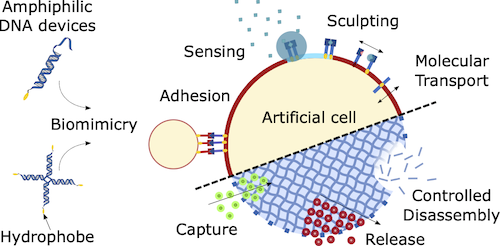Submitted by M. Rodrigues on Fri, 10/12/2021 - 09:11
Amphiphilic DNA nanostructures for bottom-up synthetic biology
A recent review by Rubio-Sanchez et al. reports the progress on the construction of cell-like objects.
DNA nanotechnology enables the construction of nano-machines that are quickly developing exciting functionality in biomimetic or cell-hybrid form. In many instances, DNA nano-devices are decorated with hydrophobic motifs so to couple them to synthetic lipid membranes as well as to regulate their bulk self-assembly.
In this manuscript the authors present recent progress on the construction of cell-like objects where bio-inspired membrane-bound DNA nanostructures achieve functionalities such as communication, adhesion and tissue formation, membrane remodelling, and transport.
It is also discussed the ability of hydrophobic modifications to drive the self-organisation of DNA building blocks into nanomaterials with programmable structure and functionality, focusing on their relevance for artificial cell research.
Finally, the authors share views on the potential that amphiphilic DNA nanotechnology has as a toolkit for bottom-up synthetic biology.
Figure legend: Amphiphilic DNA nanostructures as functional and structural elements of artificial cells. DNA nano-devices are able to impart membrane-hosted functionalities that range from sensing to membrane adhesion and patterning. Similarly, DNA nanostructures decorated with hydrophobic motifs can scaffold self-assembled membrane-less compartments with prescribed structure and functionality, providing a comprehensive toolkit for bottom-up synthetic biology
Reference: Rubio-Sanchez, R., Fabrini, G., Cicuta P. and Di Michele L. “Amphiphilic DNA nanostructures for bottom-up synthetic biology”, ChemComm (2021). https://doi.org/10.1039/D1CC04311K


